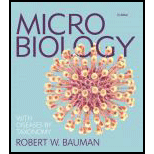
Microbiology with Diseases by Taxonomy (5th Edition)
5th Edition
ISBN: 9780134019192
Author: Robert W. Bauman Ph.D.
Publisher: PEARSON
expand_more
expand_more
format_list_bulleted
Concept explainers
Question
Chapter 13, Problem 3TMW
Summary Introduction
To determine:
The reason that lysogenic and latent viral infections are generally longer lasting than lytic infections.
Introduction:
Viruses affect both human and animals and once it enters the body, the target cell is redirected to produce more viruses. Lytic cycle occurs inside the host bacteria, in which the virus enters into host cell and replicates itself. The phages make several copies of it and come out the host cell by rupturing the membrane. In lysogenic cycle, the viral DNA is integrated into the host DNA. It does not cause lysis of the membrane of host cell. The viral genome now replicates itself along with the host DNA, and thus transferred to the progeny cells.
Expert Solution & Answer
Want to see the full answer?
Check out a sample textbook solution
Students have asked these similar questions
What is the structure and function of Eukaryotic cells, including their organelles? How are Eukaryotic cells different than Prokaryotic cells, in terms of evolution which form of the cell might have came first? How do Eukaryotic cells become malignant (cancerous)?
What are the roles of DNA and proteins inside of the cell? What are the building blocks or molecular components of the DNA and proteins? How are proteins produced within the cell? What connection is there between DNA, proteins, and the cell cycle? What is the relationship between DNA, proteins, and Cancer?
Why cells go through various types of cell division and how eukaryotic cells control cell growth through the cell cycle control system?
Chapter 13 Solutions
Microbiology with Diseases by Taxonomy (5th Edition)
Ch. 13 - Prob. 1MCCh. 13 - Which of the following statements is true? a....Ch. 13 - Prob. 3MCCh. 13 - Prob. 4MCCh. 13 - Prob. 5MCCh. 13 - Prob. 6MCCh. 13 - Prob. 7MCCh. 13 - Prob. 8MCCh. 13 - Which of the following is not a criterion for...Ch. 13 - Prob. 10MC
Ch. 13 - Match each numbered term with its description. 1....Ch. 13 - Prob. 1VICh. 13 - Prob. 2VICh. 13 - Compare and contrast a bacterium and a virus by...Ch. 13 - Prob. 2SACh. 13 - Prob. 3SACh. 13 - Prob. 4SACh. 13 - Prob. 5SACh. 13 - Prob. 6SACh. 13 - Prob. 7SACh. 13 - Prob. 8SACh. 13 - Prob. 9SACh. 13 - Compare and contrast diploid cell culture and...Ch. 13 - Larger viruses usually have a double-stranded...Ch. 13 - What are the advantages and disadvantages to...Ch. 13 - How are computer viruses similar to biological...Ch. 13 - Compare and contrast lysogeny by a prophage and...Ch. 13 - Prob. 5CTCh. 13 - Prob. 6CTCh. 13 - Prob. 7CTCh. 13 - Prob. 8CTCh. 13 - Prob. 9CTCh. 13 - What differences would you expect in the...Ch. 13 - Prob. 11CTCh. 13 - Prob. 12CTCh. 13 - Prob. 13CTCh. 13 - Using the following terms, fill in the following...Ch. 13 - Why are naked icosahedral viruses able to...Ch. 13 - What characteristics of the genomes of...Ch. 13 - Prob. 3TMWCh. 13 - Prob. 4TMWCh. 13 - Prob. 5TMWCh. 13 - Why are viruses seemingly alive and yet not alive?Ch. 13 - Prob. 7TMWCh. 13 - Prob. 1EDCSCh. 13 - Prob. 1CCS
Knowledge Booster
Learn more about
Need a deep-dive on the concept behind this application? Look no further. Learn more about this topic, biology and related others by exploring similar questions and additional content below.Similar questions
- In one paragraph show how atoms and they're structure are related to the structure of dna and proteins. Talk about what atoms are. what they're made of, why chemical bonding is important to DNA?arrow_forwardWhat are the structure and properties of atoms and chemical bonds (especially how they relate to DNA and proteins).arrow_forwardThe Sentinel Cell: Nature’s Answer to Cancer?arrow_forward
- Molecular Biology Question You are working to characterize a novel protein in mice. Analysis shows that high levels of the primary transcript that codes for this protein are found in tissue from the brain, muscle, liver, and pancreas. However, an antibody that recognizes the C-terminal portion of the protein indicates that the protein is present in brain, muscle, and liver, but not in the pancreas. What is the most likely explanation for this result?arrow_forwardMolecular Biology Explain/discuss how “slow stop” and “quick/fast stop” mutants wereused to identify different protein involved in DNA replication in E. coli.arrow_forwardMolecular Biology Question A gene that codes for a protein was removed from a eukaryotic cell and inserted into a prokaryotic cell. Although the gene was successfully transcribed and translated, it produced a different protein than it produced in the eukaryotic cell. What is the most likely explanation?arrow_forward
- Molecular Biology LIST three characteristics of origins of replicationarrow_forwardMolecular Biology Question Please help. Thank you For E coli DNA polymerase III, give the structure and function of the b-clamp sub-complex. Describe how the structure of this sub-complex is important for it’s function.arrow_forwardMolecular Biology LIST three characteristics of DNA Polymerasesarrow_forward
arrow_back_ios
SEE MORE QUESTIONS
arrow_forward_ios
Recommended textbooks for you
 Human Heredity: Principles and Issues (MindTap Co...BiologyISBN:9781305251052Author:Michael CummingsPublisher:Cengage Learning
Human Heredity: Principles and Issues (MindTap Co...BiologyISBN:9781305251052Author:Michael CummingsPublisher:Cengage Learning- Surgical Tech For Surgical Tech Pos CareHealth & NutritionISBN:9781337648868Author:AssociationPublisher:Cengage



Human Heredity: Principles and Issues (MindTap Co...
Biology
ISBN:9781305251052
Author:Michael Cummings
Publisher:Cengage Learning



Surgical Tech For Surgical Tech Pos Care
Health & Nutrition
ISBN:9781337648868
Author:Association
Publisher:Cengage